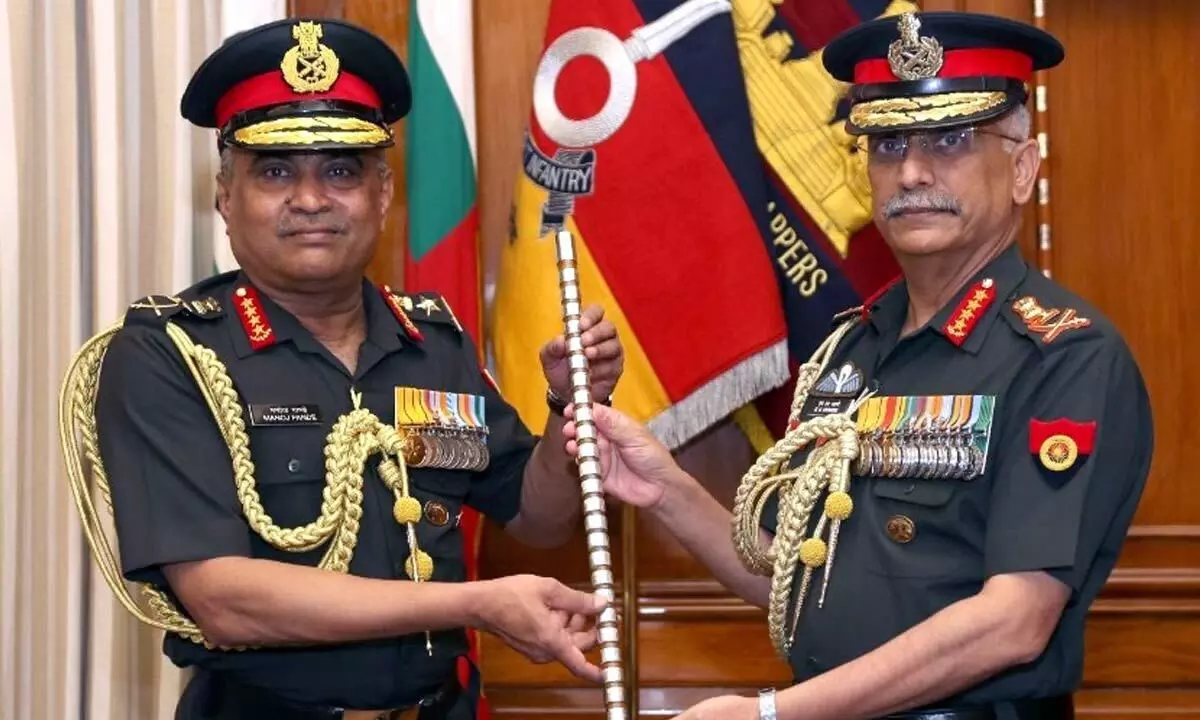Technocrat takes charge as new Army chief, suspense over CDS continues
General Manoj Pande took over the reins of Indian Army as its 29th Chief on April 30 succeeding General Manoj Mukund Naravane, and becomes first engineer to head the world's 2nd largest military force comprising 1.4 mn-strong Indian Army
image for illustrative purpose

General Manoj Pande took over the reins of Indian Army as its 29th Chief on April 30 succeeding General Manoj Mukund Naravane, who retired after serving in the top post for over two years. Although, the post of Chief of Defence Staff (CDS) continued to remain vacant. Gen Naravane, whom many had expected to be appointed the new CDS as soon as he retired since he was the senior-most among the three Service Chiefs. Disappointment is palpable among military veterans and sources in the defence establishment over the lingering suspense of CDS, a post vacant for almost five months, after the country's first CDS, General Bipin Rawat, was killed in a helicopter crash last December and considered crucial at a time when India faces security threats along its northern border with China, and Pakistan to its west. Before assuming the charge of Army Chief, Gen Pande served as the Vice-Chief of Army Staff (VCOAS) for three months. He earlier headed the Kolkata-based HQs Eastern Command, which is responsible for guarding India's borders with China in the eastern sector in Sikkim and Arunachal Pradesh sectors. His tenure saw the Indian Army deploy new weapon systems in these sectors to strengthen its deployment against China amid the border row in Ladakh.
Glass ceiling broken
Gen Pande becomes the first technocrat to head the world's second-largest military force – the 1.4 million-strong Indian Army – who belongs to the Army's Corps of Engineers, also known as 'sappers'. Officers from the 'sappers' have served as Commanders and Vice-Chiefs, but never as Army Chief. He is the first engineer to do so by breaking the glass-ceiling of Indian Army's long structured legacy of leadership inheritance as Chiefs have been from the infantry, armored corps, and artillery. Statistically, the Infantry has produced maximum number of Chief of Army Staff (COAS) followed by the Armoured corps and Artillery.
The appointment of a technical expert at the top is very significant as Indian military is currently focused on gaining technical prowess by embracing niche and disruptive technologies to fight future wars. It is expected that his engineering and technical background will spur Indian military's modernization exercise with a focus on indigenization and self-reliance.
Being the senior-most officer in the Army after General Naravane, Gen Pande's past experience and technical expertise could have played a crucial role in his elevation by the government. There is now an emerging school of thought in the military sphere that while efforts must be made to identify - tactical commanders - at battalion and brigade level, for higher posts officers with "strategic leadership" potentials should be rewarded.
He has taken over as chief at a time when the border standoff in eastern Ladakh is set to enter its third year, with a full-resolution still not in sight even though India and China have had partial success in disengaging rival soldiers from some friction areas on LAC and talks are on to end the deadlock that has cast a shadow over the bilateral relationship.
His appointment also comes as the government works on the indigenisation of military equipment – a domain that will prove particularly challenging now given the ongoing fallout of Russia's war on Ukraine. India's military preparedness is firmly in the crosshairs in this case as two-thirds of India's military equipment is of Soviet or Russian origin.
His appointment also comes at a time when India is working on a roadmap for the military's theaterisation to best utilise the resources of the three services - Army, Air Force and Navy - to fight future wars and operations. Rawat was spearheading the theaterisation drive. The CDS' demise was seen as a setback to the ongoing military reforms, including theaterisation – when assets belonging to all the services in a given theatre are marshalled together.
With that view, it has been proposed that instead of the present 19 commands - seven army commands, seven air force commands, three naval commands and two joint commands - there should be only five commands. The Northern Command, the Western Command, the Peninsular Command, a full-fledged air defence command and the Command tasked with protecting the Indian Ocean and India's Island territories.
Incidentally, General Pande has the experience of heading one of the two Joint Commands that India has at the moment - the Andaman Nicobar Command and the Strategic Forces Command - where the Army, Air Force, and the Navy work together.
He was the Commander-in-Chief of the Andaman and Nicobar Command (CINCAN) from June 2020 to May 2021. This experience of Gen Pande may prove valuable for future planning. In fact, the present government is giving topmost priority to strategic planning at the moment. Current military thinking gels with Gen Pande's technical know-how that future warfare would essentially be fought across multiple domains – land, sea, air. Cyber and space - by a joint force. Modern warfare will see the use of swarms, spy drones, unmanned ground vehicles, missiles with adaptive guidance, and robotic systems.
Gen Pande had highlighted how the future battlefield milieu, though being technology-centric, will also need a new kind of leader. "The new generation of warfare can be won by leaders who are creative, adaptive to technology, and have developed decision-making skills with profound professional knowledge," he commented while delivering his speech at the Army's think-tank, Centre for Land and Warfare Studies (CLAWS) in his speech in February. Because of his technical background, it is safe to guess that the government has picked up a suitable leader to lead the Indian Army in this challenging time.
(Author is a journalist who writes on defence, strategic affairs and technology)

